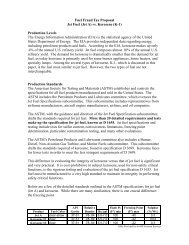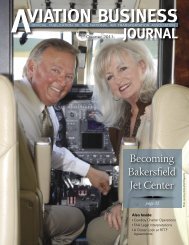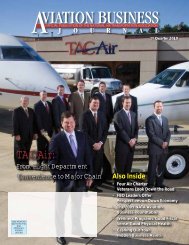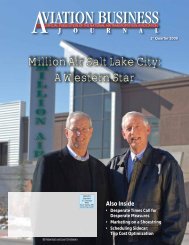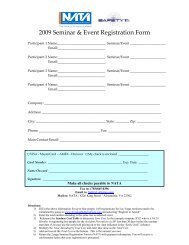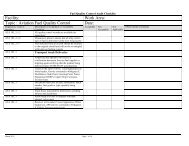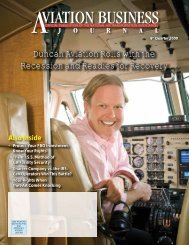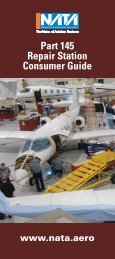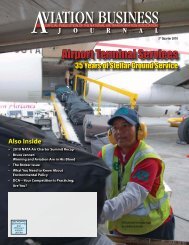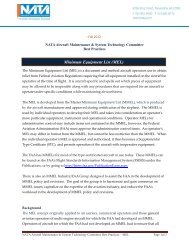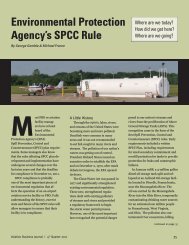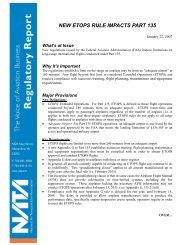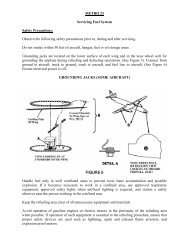Computer-Based Maintenance Tracking Flight Training ... - NATA
Computer-Based Maintenance Tracking Flight Training ... - NATA
Computer-Based Maintenance Tracking Flight Training ... - NATA
- No tags were found...
You also want an ePaper? Increase the reach of your titles
YUMPU automatically turns print PDFs into web optimized ePapers that Google loves.
ers of hours they spend in the cockpit. By reducingthese factors, schools may see an increase inenrollment.“I believe the simulator time is as much as a50 percent per hour reduction in cost,” Lotz said.“When a student has an area he needs to work on,say take-offs and landings, you just freeze frame,rewind, and he can do it over and over and overagain. You don’t have the ten-minutes flying to thepractice area each way. I think for the student thatliterally adds up to better performance of skill setsand better understanding in half the time. The goalis to produce a better pilot in less time.”Lotz said that while the FAA credits only 2.5hours of simulation time, a typical student atMonterey Bay Aviation will spend an additional 10hours in a simulator learning and practicing skills.Proponents of FTDs and simulators do warn thattime in front of a screen should never completelyreplace time in the air. The key, they say, is tostrike the right balance between simulation andreal-world experience.New Demand for <strong>Flight</strong> <strong>Training</strong>Lotz feels that with upcoming modernization of theAir Traffic Control system and broader use of glasscockpits, the flight training industry is due for anupgrade. Additionally, the introduction of very lightjets will make high-performance flight more popularat a time when many flight schools are closingtheir doors.Despite the barrier to entry posed by the highcost of realistic simulators, Lotz feels that if a flightschool runs its operation as a business, the initialinvestment will be well worth the cost.Fewer flight schools will be graduating fewer studentsat a time when many commercial pilots willbe retiring. This shortage of pilots will lead to higherwages, which will in turn attract new studentslooking at aviation as a career field. This, coupledwith the expansion of regional airlines and greateraccessibility of private aircraft, will create tremendousdemand for those few remaining schools thathave modernized to keep up with the times.Skovgaard went even further, warning that ashortage of high-quality CFIs could have a potentiallydevastating impact on general aviation. Heexplained that many regional airlines are snappingup instructors with relatively few hours to workas pilots, and this is leaving a shortfall in qualifiedinstructors. “You have to have more eggs to makemore chickens,” he said.Assessing your market and determining if anFTD fits into your business model are long-term,considerable investments of time and money. Butthere are simple, low-cost steps flight schools cantake to be more customer-centric. “I call it changingthe customer service model,” Lotz said.Changing the Customer Service ModelLotz feels that many flight schools still operate asthey did 30, 40, or even 50 years ago. Phones areoften not answered, and when they are the personanswering them lacks basic knowledge about thetraining program. Facilities are in poor condition,restrooms are dirty, aircraft are not well maintained,and schools have a general shoddy appearance.“I mean, how tough is it to clean a restroom?”Lotz wondered. “You don’t need to build the TajMahal, but you should make an effort to have a nicefacility. This is the same level of service they arealready getting when they take their Lexus to thedealer for service. We are only doing catch-up work;we are not doing innovation. We are just getting upto the norm of most industries.”Lotz suggests training staff in customer serviceskills, building a website with basic informationabout your program, and participating in flighttraining cooperative programs such as Be A Pilot.Lotz said that for some students the time-costratio will always be a factor that discourages themfrom pursuing a private pilot’s license. However,there are large markets of young students who havenot decided on a career field, retirees who wouldbe interested in getting a recreational license, andthousands of affluent personal users who are stillinterested.“The key is to know your market and innovate tomeet that demand,” he said.Aviation Business Journal | 3 rd Quarter 200737


